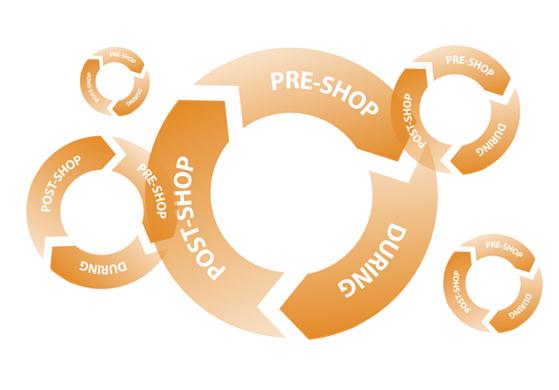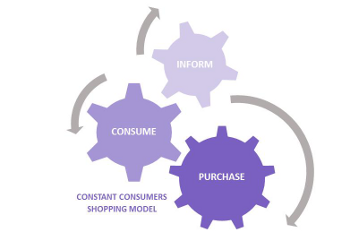BELLEVUE, Wash. (Hartman Group) — In early 2005, The Hartman Group’s inaugural Shopper Insights research shattered many myths surrounding the drivers behind consumers’ shopping behavior. This initial foray into the field of Shopper Insights was, by design, exploratory, and the single most salient conclusion we reached is that understanding shopping behavior requires understanding the daily routines of consumers and how shopping fits into those routines.
What happens in a store and what drives consumers to choose one store over another have everything to do with what happens before they get there and very little to do with most of the marketing and merchandising strategies and tactics currently in play.
Marketers, brand managers, analysts, and others have recognized for several years the important interplay between consumer behavior and consumer experience in the retail setting. Yet, despite all of the assorted research, dialogues, discussions, and strategizing, we’ve witnessed little concrete progress in the pursuit of a comprehensive, integrated understanding of shopping behavior.
In our Shopping Topography 2012 report (intensive and immersive research into the purchase decision-making and shopping habits of America’s consumers), we expanded the boundaries of path to purchase to encompass the full range of consumer attitudes and behaviors that bear on shopping. Ultimately, our qualitative ethnographic fieldwork led to a much more insightful, holistic understanding of the contemporary cultural dynamics of shopping behavior. The cultural context of shopping connects directly to the routines of everyday life. Common household tasks have significant implications for what consumers buy and where they shop. Knowing how shopping fits into the daily routine of consumers is key to understanding shopping behavior.
Another important aspect of taking a holistic approach to understanding consumers’ path to purchase is recognizing the fundamental role of change. Consumer behavior is constantly changing and evolving. And, as we learned in our Shopping Topography research, perhaps it is time to retire the old, linear pre-, during and post-shopping path-to-purchase model as today’s consumers are veering off this well-traveled traditional route.
Meet the Constant Consumer
Consumers and retailers are continuing to blur the boundaries between traditional shopping channels; technology has become integrated into consumers’ lives in ways unimagined a few short years ago, so, consequently, the old ways of thinking about path to purchase have to change.
“The days of shopping trips to one store just to fill the pantry are long gone,” says Laurie Demeritt, The Hartman Group’s president and COO. “For today's consumers, shopping is very much in constant motion; it’s a virtual 24-hour, seven-day-a-week activity. The consumer is now in total control of the shopping process, not the manufacturer or the retailer.”
Today’s consumer no longer shops in a linear fashion. Traditional shopping models divide shopping behavior into clearly delineated phases that follow a predictable continuum of habitual actions:

However, we find that this traditional linear model no longer captures the full complexity of how consumers shop today, given their busy and tech-connected lifestyles. What once appeared to be a direct purchase path has become an asynchronous series of events that is managed by the consumer, not the providers.

Today, consumers find themselves in multiple, and often simultaneous, stages of purchase as they navigate choices, channels, and information sources, seeking the best value throughout the day (or night) at various venues, including the corner store, their living room couch or even their car.
To make sense of this complexity, we believe it is best to think of shoppers as “Constant Consumers” whose path to purchase is actually more much circuitous than linear, with three interlocking and interdependent elements that more accurately explain the why behind the consumer buy.
 These elements have a symbiotic relationship. Any one of these elements is a potential trigger that can set the other elements into motion at any time. The new model does not focus on the single path to one product but, rather, looks at the ongoing process of purchase through the eyes and mind of today’s consumer. The three elements are:
These elements have a symbiotic relationship. Any one of these elements is a potential trigger that can set the other elements into motion at any time. The new model does not focus on the single path to one product but, rather, looks at the ongoing process of purchase through the eyes and mind of today’s consumer. The three elements are:
Inform: represents the key sources of consumer knowledge, broken down into the two most influential categories: PEOPLE and MEDIA + MARKETING. People can include those closest to the consumer, like their significant other or children of the staff who work at the stores they visit. Media and Marketing includes traditional media, new media, and traditional in-store marketing. These two groups encourage purchase and inspire consumption.
Purchase: Consumers work in two modes across all channels: BROWSE + BUY and SEARCH + RETRIEVE. They toggle between modes, depending on mission, needs, and the personal interests that trigger purchase. Consumers who employ the BROWSE + BUY strategy like to wander the aisle, discovering new products or diving into the dollar bins. SEARCH + RETRIEVE consumers are laser-focused and like to get what they need and get out of the store.
Consume: There are IMMEDIATE and PLANNED consumption moments. Immediate consumption occurs when consumers use or eat a product soon after purchase. Planned consumption is future-oriented; consumers like to have products on hand for when the need arises. PLANNED consumption is most influential in triggering inform and purchase. IMMEDIATE consumption directly triggers purchase.
Extending Shopper Insights
The Constant Consumer is always shopping. Acknowledging change directs our attention to aspects of consumer behavior that we would not otherwise consider. In these past several years, for example, the U.S. has experienced a significant shift in population that has had a dramatic influence on purchasing patterns and consumer needs. This melting pot of cultures, ethnicities, values, and lifestyles reflects a series of choices and attitudes that impact every part of the Constant Consumer model: INFORM, PURCHASE, and CONSUME.
Even with today’s disrupted systems, shopping remains core to the consumer’s everyday world. Keep the Constant Consumer model in mind as you consider marketing strategies, messaging, and experiences—the consumer is shopping at any moment, from any place, and is constantly using a fusion of shopping modes, information sources, and technologies to make choices. You never know at which point they are entering the path to purchase to check out your brands, products, or services—or those of your competitors.


















